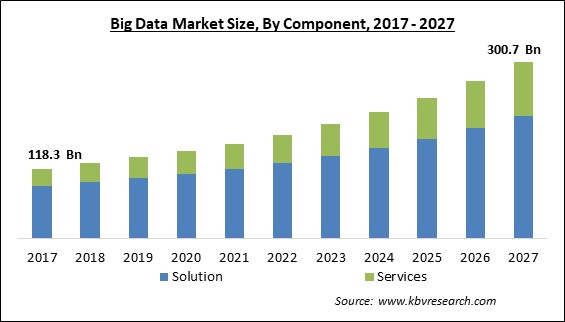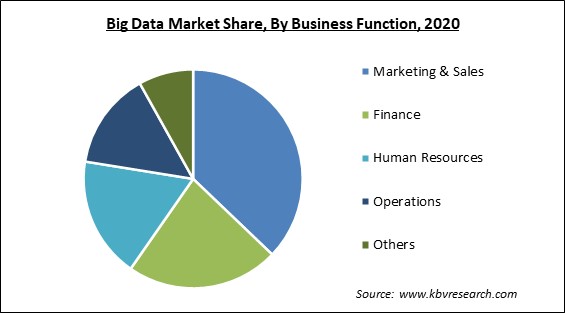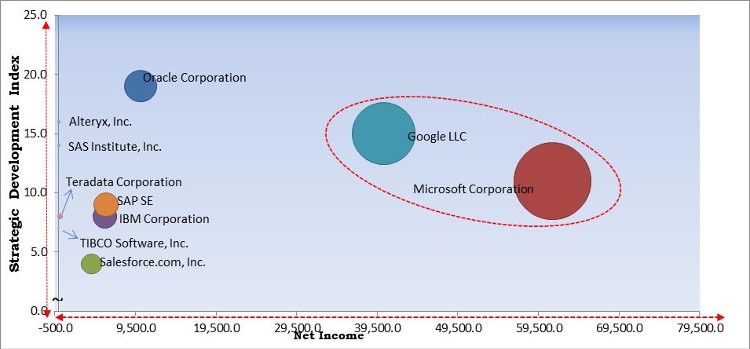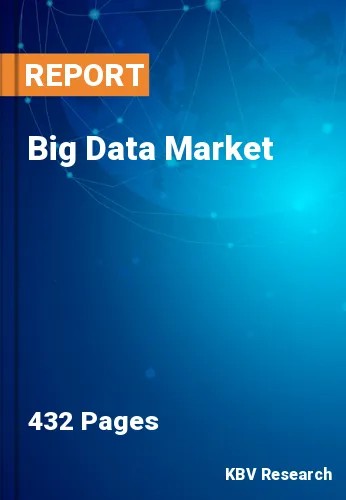The Global Big Data Market size is expected to reach $300.7 billion by 2027, rising at a market growth of 10.9% CAGR during the forecast period.
Big data is described as large amounts of unstructured or semi-structured data that have been accumulated over time. Big data is frequently unstructured and scattered. The term "Big Data" also refers to the sheer amount of data accumulated, as well as its speed, velocity, diversity, and complexity. Traditional database management systems struggle to process and/or handle these massive data collections, which are measured in petabytes/exabytes of data. Big data is defined in this study as an enormous dataset that does not fit into standard business database designs. RFID readers, social networks, sensor networks, internet text and documents, phone registers, internet search indexing, scientific research studies, medical records, military surveillance, and eCommerce, among many other sources, generate big data.
Big data combines information from a variety of sources and applications. Extract, transform, and load (ETL) are common data integration procedures that aren't up to the challenge. To evaluate large data sets on a terabyte or even petabyte-scale, new methodologies and technologies are required. During the integration process, one must bring in the data, process it, and ensure that it is prepared and available in a way that the business analysts can use.
Space for storage is required for big data. The storage solution can be cloud-based, on-premises, or a combination of both. Users can store their data in any format they want, and then apply their processing needs and process engines to those data sets as needed. The decision by people regarding where to store their data is based on where their data is currently stored. Since it satisfies businesses' present computation requirements and allows them to spin up resources as needed, the cloud is quickly gaining appeal.
Users can make new findings with larger data sets. To that aim, new investments in skills, organization, or infrastructure must be made in the context of a strong business-driven environment in order to ensure continuous project investments and funding. Understanding how to filter site logs to analyze e-commerce activity, extracting sentiment from social media and customer support contacts, and statistical correlation approaches and their significance for the customer, product, manufacturing, and engineering data are just a few examples.

COVID-19 has had three primary repercussions on the global economy: it has had a direct and negative influence on production and demand, disrupted supply chains and marketplaces, and impacted enterprises and financial markets financially. The COVID-19 pandemic, on the other hand, has had a beneficial impact on the Big Data market, since the usage of Big Data has expanded in order to better comprehend the impact of COVID-19 on the economy. As the pandemic continues and new waves keep coming, the impact of the outbreak on the big data market could be negative. This is due to governments in the majority of countries imposing a state of emergency and prohibiting travel to prevent the spread of the virus. However, following the recovery from the COVID-19 pandemic, the big data and business analytics market is expected to grow in the following years.
Owing to the increase in the popularity of social media, the Internet of Things (IoT), and multimedia, which have produced an excessive flow of data in either structured or unstructured format, the volume of data gathered by enterprises is constantly expanding. The growth of data creation has been exponential in the past few years, especially after the wide proliferation of smartphones and social media. Machine-generated as well as human-generated data is growing at a rate ten times faster than traditional commercial data. Machine data is growing at a much quicker rate than human data. Big data is predominantly consumer-driven and oriented; most of the data in the world is created by 'always-on' customers. Typically, people spend a vast proportion of each day using a range of gadgets and (social) applications to consume and generate data.
Organizations are seeking to harness information assets to improve customer connections, business outcomes, and operational efficiency, and big data analytics is in high demand. However, keeping up with the shifting demands and expectations of a growing number of big data analytics consumers has grown more difficult. Emerging developments in big data analytics, such as social media analytics and text analytics, on the other hand, are expected to open up a slew of new prospects for the sector. Moreover, because social media is more effective than traditional advertising, many organizations have made it their primary source for various advertising campaigns, product promotions, and events. The ever-increasing competition among businesses is forcing them to use big data analytics to improve their growth.
On big data platforms, users save sensitive data and information about company activities. However, handling and preserving the documents can expose to a variety of risks and vulnerabilities. As the platform grows in popularity, so do security concerns about data breaches, unforeseen events, application vulnerabilities, and information loss. Some sectors, such as academia and research, federal government departments, and financial services, may experience revenue reductions as a result of information security and privacy concerns. This can significantly harm a company's reputation and, as a result, undermine the confidence of those in charge. As a result, criminal sanctions and even legal culpability may be imposed. Cybercriminals can subvert important company information and engage in unlawful transactions by storing sensitive information and data in databases and on the cloud. As a result, security and privacy concerns are projected to hamper market growth over the forecast period.

Based on Component, the market is segmented into Solution (Data Discovery, Big Data Analytics, Data Visualization, and Data Management) and Services. The services segment observed a substantial revenue share in the big data market in 2020. Big data consulting services include big data strategy, real-time big data processing, machine learning, data platform management, and analytics solutions, and there are various organizations active in the big data market that provide these services.
Based on Business Function, the market is segmented into Marketing & Sales, Finance, Human Resources, Operations, and Others. The marketing and sales segment acquired the largest revenue share in the big data market in 2020. Big data in marketing and sales reveals which content is most efficient at each stage of the sales process, as well as how to improve investments in Customer Relationship Management (CRM) systems and strategies for increasing conversion rates, prospect interaction, conversion rates, revenue, and customer lifetime value. Big data provides insights on how to minimize Customer Acquisition Cost (CAC), Customer Lifetime Value (CLTV), and monitor many other customer-driven indicators necessary to running a cloud-based business for cloud-based enterprise software enterprises.
Based on Deployment Type, the market is segmented into On-premise and Cloud (Public, Private, and Hybrid). The on-premise segment recorded the largest revenue share in the big data market in 2020. The on-premises deployment strategy of big data solutions is preferred by businesses in heavily regulated sector verticals such as BFSI, healthcare and life sciences, and manufacturing. Large businesses with adequate IT resources are also likely to choose the on-premises deployment strategy. On-premises deployment is the most dependable deployment strategy, providing a high level of control and protection to an organization. To use cloud-based products, businesses must pay for a license or a copy.
Based on Organization Size, the market is segmented into Large Enterprises and Small & Medium Enterprises (SMEs). The SMEs segment recorded a substantial revenue share in the big data market in 2020. SMEs tend to generate much fewer data as compared to large enterprises and multinational corporations and thus their demand for big data services and solutions is relatively low. SMEs also tend to prefer the cloud deployment of big data storage and analysis as it helps them keep their costs low.
Based on Vertical, the market is segmented into BFSI, Retail & Consumer Goods, Telecom & IT, Government & Defense, Healthcare & Life Sciences, Manufacturing, Media & Entertainment, Transportation & Logistics, and Others. The retail and consumer goods segment witnessed a substantial revenue share in the big data market in 2020. In the retail sector, big data analytics allows businesses to make custom recommendations based on their purchase history, resulting in more personalized shopping experiences and better customer care. In the retail industry, big data is crucial for developing an appropriate sales strategy. To understand customer behavior, predict demand, and improve price, big data is being used at every level of the retail process.
| Report Attribute | Details |
|---|---|
| Market size value in 2020 | USD 149 Billion |
| Market size forecast in 2027 | USD 300.7 Billion |
| Base Year | 2020 |
| Historical Period | 2017 to 2019 |
| Forecast Period | 2021 to 2027 |
| Revenue Growth Rate | CAGR of 10.9% from 2021 to 2027 |
| Number of Pages | 432 |
| Number of Tables | 773 |
| Report coverage | Market Trends, Revenue Estimation and Forecast, Segmentation Analysis, Regional and Country Breakdown, Competitive Landscape, Companies Strategic Developments, Company Profiling |
| Segments covered | Component, Business Function, Deployment Mode, Organization Size, Vertical, Region |
| Country scope | US, Canada, Mexico, Germany, UK, France, Russia, Spain, Italy, China, Japan, India, South Korea, Singapore, Malaysia, Brazil, Argentina, UAE, Saudi Arabia, South Africa, Nigeria |
| Growth Drivers |
|
| Restraints |
|
Based on Regions, the market is segmented into North America, Europe, Asia Pacific, and Latin America, Middle East & Africa. North America emerged as the leading region with the highest revenue share in the big data market in 2020. Most enterprises and verticals in North America regard data discovery and big data analytics to be quite productive. The high adoption rate of advanced solutions and services across various nations of the region is contributing to the growth of the regional market during the forecast period.
Free Valuable Insights: Global Big Data Market size to reach USD 300.7 Billion by 2027

The major strategies followed by the market participants are Partnerships. Based on the Analysis presented in the Cardinal matrix; Microsoft Corporation and Google LLC are the forerunners in the Big Data Market. Companies such as Oracle Corporation, SAP SE and IBM Corporation are some of the key innovators in the Market.
The market research report covers the analysis of key stake holders of the market. Key companies profiled in the report include IBM Corporation, Google LLC, Oracle Corporation, Microsoft Corporation, SAS Institute, Inc., SAP SE, Alteryx, Inc., Teradata Corporation, Salesforce.com, Inc., and TIBCO Software, Inc.
By Component
By Business Function
By Deployment Mode
By Organization Size
By Vertical
By Geography
The big data market size is projected to reach USD 300.7 billion by 2027.
Exponential growth in data availability are driving the market in coming years, however, Privacy Concerns and Strict Data Security Regulations Implemented by the Government limited the growth of the market.
IBM Corporation, Google LLC, Oracle Corporation, Microsoft Corporation, SAS Institute, Inc., SAP SE, Alteryx, Inc., Teradata Corporation, Salesforce.com, Inc., and TIBCO Software, Inc.
Yes, the recovery from the COVID-19 pandemic, the big data and business analytics market is expected to grow in the following years.
The Solution segment acquired maximum revenue share the Global Big Data Market by Component in 2020, thereby, achieving a market value of $208.7 billion by 2027.
The North America is the fastest growing region in the Global Big Data Market by Region in 2020, and would continue to be a dominant market till 2027.
Our team of dedicated experts can provide you with attractive expansion opportunities for your business.

